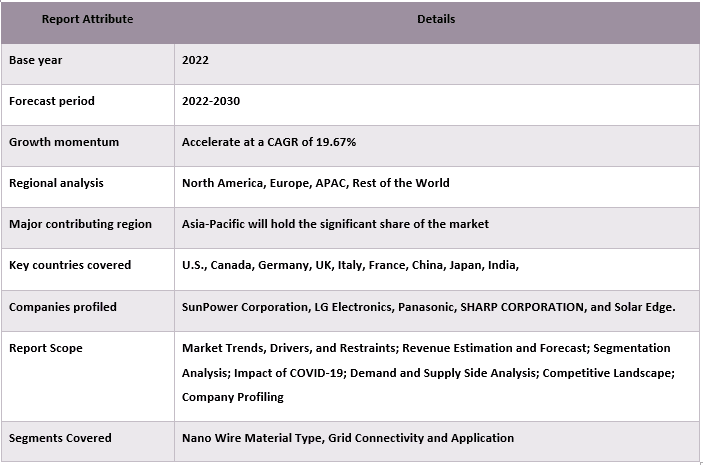- Home
- About Us
- Industry
- Services
- Reading
- Contact Us
Hairy Solar Panels Market: Current Analysis and Forecast (2023-2030)
Emphasis on Nano wire material type (Silicon, Gallium Arsenide, Indium Gallium Phosphide, Perovskite, and Others), Grid Connectivity (On-Grid and Off-Grid), Application (Residential, Commercial, and Industrial) and Region/Country

The hairy solar panels market is expected to grow at a strong CAGR of around 19.67% during the forecast period. Hairy solar panels align with the growing focus on sustainable technologies. The reduced need for water-intensive cleaning methods contributes to environmental conservation, making them attractive in regions facing water scarcity. In regions where governments provide incentives for adopting renewable energy technologies, including solar power, the development and adoption of innovative technologies like hairy solar panels may be accelerated. Companies aiming to differentiate themselves in the solar energy market may adopt hairy solar panels as a unique selling point. This can contribute to market competitiveness and potentially increase market share.
Some of the major players operating in the market are SunPower Corporation, LG Electronics, Panasonic, SHARP CORPORATION, and Solar Edge. Several M&As along with partnerships have been undertaken by these players to facilitate customers with hi-tech and innovative products/technologies.
Insights Presented in the Report
“Amongst grid connectivity, the on-grid segment will hold significant growth in the market.”
Based on grid connectivity, the market is segmented into on-grid and off-grid. Amongst these, the on-grid segment will hold significant growth in the market. This growth is because the on-grid systems allow for energy sharing and net metering. Excess energy generated by hairy solar panels during periods of high sunlight can be fed back into the grid, and users may receive credits or compensation. This financial incentive encourages the adoption of on-grid hairy solar panel systems.
“Amongst application, the residential segment will experience the significant growth of the market.”
Based on application, the market is segmented into residential, commercial, and industrial. Among these, the residential segment will hold a significant growth in the hairy solar panels market because over the time, hairy solar panels can lead to significant cost savings on electricity bills for homeowners. The appeal of reducing long-term energy expenses will make residential installations economically attractive, fostering market growth. Moreover, in densely populated urban areas where space is limited, hairy solar panels’ design flexibility allows for creative and efficient use of available rooftop space, making them suitable for residential applications in cities.
“Europe will experiencing a significant growth in the hairy solar panels market in 2022.”
Many European countries have set ambitious renewable energy targets to reduce carbon emissions and combat climate change. The adoption of innovative technologies like hairy solar panels aligns with these targets and drives growth in the region. Europe has a strong tradition of technological innovation, and this extends to the renewable energy sector. Ongoing research and development efforts contribute to the advancement of hairy solar panel technologies, making them more attractive for widespread adoption. Hairy solar panels can contribute to grid stability by providing a distributed and decentralized energy source. In regions where grid reliability is crucial, the integration of these panels can enhance the resilience of the energy infrastructure. The availability of investment and funding for renewable energy projects in Europe plays a crucial role in the growth of the market. Investors are increasingly recognizing the long-term potential and sustainability of technologies like hairy solar panels.
Hairy Solar Panels Market Report Coverage

Reasons to buy this report:
- The study includes market sizing and forecasting analysis validated by authenticated key industry experts.
- The report presents a quick review of overall industry performance at one glance.
- The report covers an in-depth analysis of prominent industry peers with a primary focus on key business financials, product portfolios, expansion strategies, and recent developments.
- Detailed examination of drivers, restraints, key trends, and opportunities prevailing in the industry.
- The study comprehensively covers the market across different segments.
- Deep dive regional level analysis of the industry.
Customization Options:
The global hairy solar panels market can further be customized as per the requirement or any other market segment. Besides this, UMI understands that you may have your own business needs, hence feel free to connect with us to get a report that completely suits your requirements.
Table of Content
Research Methodology for the Hairy Solar Panels Market Analysis (2022-2030)
Analyzing the historical market, estimating the current market, and forecasting the future market of the global hairy solar panels market were the three major steps undertaken to create and analyze the adoption of hairy solar panelss in major regions globally. Exhaustive secondary research was conducted to collect the historical market numbers and estimate the current market size. Secondly, to validate these insights, numerous findings and assumptions were taken into consideration. Moreover, exhaustive primary interviews were also conducted, with industry experts across the value chain of the global hairy solar panels market. Post assumption and validation of market numbers through primary interviews, we employed a top-down/bottom-up approach to forecasting the complete market size. Thereafter, market breakdown and data triangulation methods were adopted to estimate and analyze the market size of segments and sub-segments of the industry pertains to. Detailed methodology is explained below:
Analysis of Historical Market Size
Step 1: In-Depth Study of Secondary Sources:
Detail secondary study was conducted to obtain the historical market size of the hairy solar panels market through company internal sources such as annual reports & financial statements, performance presentations, press releases, etc., and external sources including journals, news & articles, government publications, competitor publications, sector reports, third-party database, and other credible publications.
Step 2: Market Segmentation:
After obtaining the historical market size of the hairy solar panels market, we conducted a detailed secondary analysis to gather historical market insights and share for different segments & sub-segments for major regions. Major segments are included in the report as nano wire material type, grid connectivity and application. Further country-level analyses were conducted to evaluate the overall adoption of testing models in that region.
Step 3: Factor Analysis:
After acquiring the historical market size of different segments and sub-segments, we conducted a detailed factor analysis to estimate the current market size of the hairy solar panels market. Further, we conducted factor analysis using dependent and independent variables such as nano wire material type, grid connectivity and application of the hairy solar panels market. A thorough analysis was conducted of demand and supply-side scenarios considering top partnerships, mergers and acquisitions, business expansion, and product launches in the hairy solar panels market sector across the globe.
Current Market Size Estimate & Forecast
Current Market Sizing: Based on actionable insights from the above 3 steps, we arrived at the current market size, key players in the global hairy solar panels market, and market shares of the segments. All the required percentage shares split, and market breakdowns were determined using the above-mentioned secondary approach and were verified through primary interviews.
Estimation & Forecasting: For market estimation and forecast, weights were assigned to different factors including drivers & trends, restraints, and opportunities available for the stakeholders. After analyzing these factors, relevant forecasting techniques i.e., the top-down/bottom-up approach were applied to arrive at the market forecast for 2028 for different segments and sub-segments across the major markets globally. The research methodology adopted to estimate the market size encompasses:
- The industry’s market size, in terms of revenue (USD) and the adoption rate of the hairy solar panels market across the major markets domestically
- All percentage shares, splits, and breakdowns of market segments and sub-segments
- Key players in the global hairy solar panels market in terms of products offered. Also, the growth strategies adopted by these players to compete in the fast-growing market.
Market Size and Share Validation
Primary Research: In-depth interviews were conducted with the Key Opinion Leaders (KOLs) including Top Level Executives (CXO/VPs, Sales Head, Marketing Head, Operational Head, Regional Head, Country Head, etc.) across major regions. Primary research findings were then summarized, and statistical analysis was performed to prove the stated hypothesis. Inputs from primary research were consolidated with secondary findings, hence turning information into actionable insights.
Split of Primary Participants in Different Regions

Market Engineering
The data triangulation technique was employed to complete the overall market estimation and to arrive at precise statistical numbers for each segment and sub-segment of the global hairy solar panels market. data was split into several segments & sub-segments post studying various parameters and trends in the areas of the vehicle type and technology in the global hairy solar panels market.
The main objective of the Global Hairy Solar Panels Market Study
The current & future market trends of the global hairy solar panels market were pinpointed in the study. Investors can gain strategic insights to base their discretion for investments on the qualitative and quantitative analysis performed in the study. Current and future market trends determined the overall attractiveness of the market at a regional level, providing a platform for the industrial participant to exploit the untapped market to benefit from a first-mover advantage. Other quantitative goals of the studies include:
- Analyze the current and forecast market size of the hairy solar panels market in terms of value (USD). Also, analyze the current and forecast market size of different segments and sub-segments.
- Segments in the study include areas of the nano wire material type, grid connectivity and application.
- Define and analyze the regulatory framework for the hairy solar panels
- Analyze the value chain involved with the presence of various intermediaries, along with analyzing customer and competitor behaviors of the industry.
- Analyze the current and forecast market size of the hairy solar panels market for the major region.
- Major countries of regions studied in the report include Asia Pacific, Europe, North America, and the Rest of the World
- Company profiles of the hairy solar panels market and the growth strategies adopted by the market players to sustain in the fast-growing market.
- Deep dive regional level analysis of the industry
Frequently Asked Questions FAQs
Q1: What is the current market size and growth potential of the global hairy solar panels Market?
Q2: What are the driving factors for the growth of the global hairy solar panels market?
Q3: Which segment has the largest share of the global hairy solar panels market by grid connectivity?
Q4: Which region will dominate the global hairy solar panels Market?
Q5: Who are the key players operating in the global hairy solar panels market?
Related Reports
Customers who bought this item also bought










